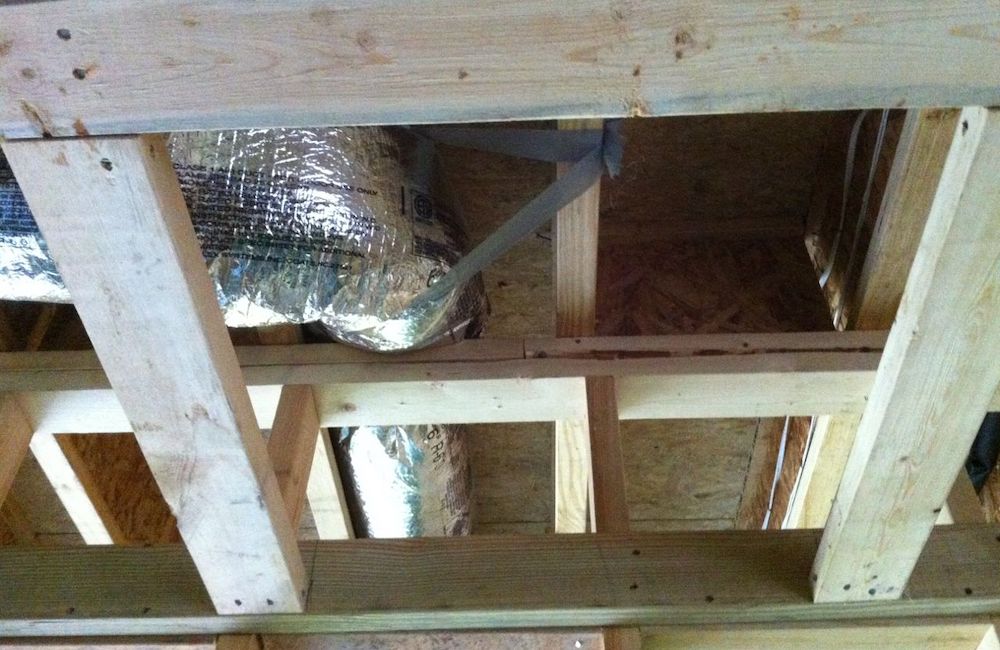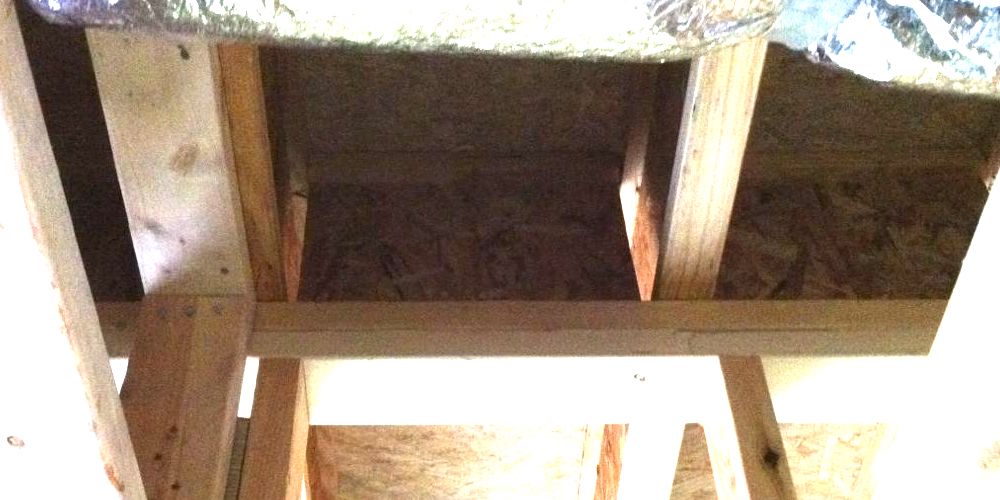I-Joists, Attached Garages, and the Air Leaks That Poison

A home with an attached garage is usually a home in which people breathe more carbon monoxide (CO). Of course, having an open carport or detached garage is better for air quality (and a feature that usually gets points for you in green building programs like LEED for Homes and EarthCraft House), but what if you don’t want to give up that attached garage?
You can do some things to minimize the amount of CO you breathe, and it starts with air sealing. One place where you really have to pay attention is where the garage’s ceiling joists cross the walls into the conditioned space. If the joists run parallel to the building enclosure wall, your job isn’t that hard. If the joists are perpendicular to the building enclosure wall, however, you’ll have open cavities that have to be blocked and sealed all along the top of that wall.
Look at the photo above. The joists in this home run right across the building enclosure wall between the conditioned space and the attached garage. You can see a flex duct running through one cavity and some blocking in the cavity to the right of where the duct is. (You have to look up at the top because there’s also a lowered soffit with extra framing that complicates the photo.) This house is still under construction, and the builder will finish the air sealing.
That duct, however, presents a problem. It’s really difficult to seal around a flex duct. A better method to run flex ducts through the building enclosure is to put solid blocking in first, then cut a hole, install a collar, and attach two separate pieces of duct to the two sides. (I’m still waiting to see one done that way so I can get a good photo of that detail. For now, you’ll just have to use your imagination.)
Without getting a good rigid air seal there, that cavity is probably going to hurt the results of the Blower Door test. Even if they spray a ton of foam in there to get it sealed up initially, things shift over time. Or maybe the drywall installer will reach in there and push the duct, causing the foam to break loose.

The other problem here is that the joists in this house aren’t made of dimensional lumber; they’re I-joists. As you can see in the photo above, you have to make sure that you finish the process of air sealing and fill those gaps on the sides of the blocking. It’s extra work but very important when you’re trying to keep carbon monoxide out of the house.
Defining the building enclosure is critical. The designer and the builder should know exactly where it is and how they’re going to handle these types of air sealing details.
Allison A. Bailes III, PhD is a speaker, writer, building science consultant, and the founder of Energy Vanguard in Decatur, Georgia. He has a doctorate in physics and writes the Energy Vanguard Blog. He also has written a book on building science. You can follow him on Twitter at @EnergyVanguard.
Related Articles
Air Barrier Sleuthing – Building Envelope Lessons for DET Verifiers
Comments are closed.
This Post Has 6 Comments
Comments are closed.

Allison just a thought, If
Allison just a thought, If any of your followers/bloggers come across a job done right in these areas could they provide EV a picture. Also some architectural computer programs have the ability to design an exploded view or completed view if anyone would have something recent. My program is for XP or below and is useless now. But I understood exactly what you were meaning. The best is a detached garage even if it has a short enclosed hallway only making the connection to the house/garage. Real easy to seal that at both ends and even vent the hallway roof for extra efficientcy. Energy Star Rated exterior doors on both house and Garage of course. Also if possible do not put a laundry area in the Garage. I’m not sure but most builders/contractors have done away with this practice.
Allison,
Allison,
In my experience traveling around the country doing field monitoring, I have seen that this is one of the consistently challenging areas in new construction, especially considering the many penetrations that are often necessary due to design and sequencing. Raters know this but architects, builders, tradespeople, and home buyers also need to be aware. Builders are leaps and bounds ahead of where they were in mitigating difficult to address leakage pathways that in many cases were not really necessary day one in the design process. Good design can reduce the need for call backs or training trades on how to deal with myriad possible difficult details. Make it beautiful and make it work. Of course. Good work.
I thought joist spaces
I thought joist spaces between conditioned space and attached garage had to be firestopped, regardless of CO and infiltration concerns?
Good idea about using a metal collar to pass flex duct through joist blocking. Better would be to install a metal supply trunk and only use flex for short run-outs to the diffusers. The important thing is to install the blocking before the trades, and make sure they all understand that their holes should be small as possible.
In my previous home, I had a plumber just knock out one of the OSB blocking panels. The next day, I asked him to replace the blocking. He said that wasn’t his problem. The next day he was unemployed (his boss, who had been away the previous two days, had previous told him to route his pipes through the blocking).
Once builders start paying attention to blower door results, they are usually pretty good at figuring out how solve problems like these. I always provide clients with a link to the ES thermal bypass guidebook, to save them from having to reinvent the wheel.
Ken – why no laundry room in
Ken – why no laundry room in the garage?
I worry as much about NOx and
I worry as much about NOx and unburned hydrocarbons which will affect you long term. CO either kills you or doesn’t.
Several years ago I did an
Several years ago I did an energy evaluation on a recently purchased older home, and found this same open connection to the basement-level garage. When I told the homeowner how hazardous this was, they told me they had bought the house on an estate sale. The previous homeowner had started her car, went back inside and answered a phone call and died of carbon monoxide poisoning.